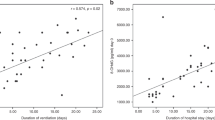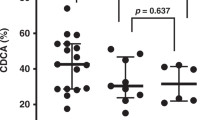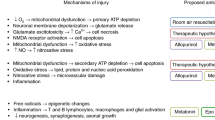Abstract
Objective:
Lipid peroxidation, DNA damage and total antioxidant status (TAS) were assessed in neonates with unconjugated hyperbilirubinemia (UCH).
Study Design:
Plasma malondialdehyde (MDA), 8-hydroxy-2-deoxy-guanosine (8-OH-dG) and TAS levels were compared between 64 term newborns with idiopathic UCH and 30 age-matched healthy controls.
Result:
Compared with controls, an overall increase in mean plasma MDA and 8-OH-dG levels and a decrease in TAS level were noted in the UCH group. Within the UCH group, mean plasma MDA level was found to be low in infants with lower bilirubin levels, but a progressive increase was documented above the bilirubin level of 20 mg dl−1. A significant increase in 8-OH-dG level was documented even at lower bilirubin levels, and a decrease in plasma TAS level was found at bilirubin levels above 16 mg dl−1. MDA and 8-OH-dG levels were significantly higher, whereas TAS level was significantly lower in five neonates who developed features of acute bilirubin encephalopathy compared with those with normal outcome. Alteration of MDA, 8-OH-dG and TAS levels showed high predictive accuracy for poor outcome.
Conclusion:
Moderate-to-severe UCH was associated with higher oxidative stress and lower antioxidant defense. Alteration of oxidative stress parameters may be utilized as early predictors for poor outcome. High DNA damage even at lower bilirubin levels suggests possible genotoxic effect of bilirubin in UCH.
This is a preview of subscription content, access via your institution
Access options
Subscribe to this journal
Receive 12 print issues and online access
$259.00 per year
only $21.58 per issue
Buy this article
- Purchase on Springer Link
- Instant access to full article PDF
Prices may be subject to local taxes which are calculated during checkout



Similar content being viewed by others
References
Maisels MJ . Neonatal hyperbilirubinemia and kernicterus - not gone but sometimes forgotten. Early Hum Dev 2009; 85: 727–732.
Kaplan M, Bromiker R, Hammerman C . Severe neonatal hyperbilirubinemia and kernicterus: are these still problems in the third millennium? Neonatology 2011; 100: 354–362.
Mayer M . Association of serum bilirubin concentration with risk of coronary artery disease. Clin Chem 2000; 46: 1723–1727.
Sedlak TW, Saleh M, Higginson DS, Paul BD, Juluri KR, Snyder SH . Bilirubin and glutathione have complementary antioxidant and cytoprotective roles. Proc Natl Acad Sci USA 2009; 106: 5171–5176.
Jansen T, Daiber A . Direct antioxidant properties of bilirubin and biliverdin. Is there a role for biliverdin reductase? Front Pharmacol 2012; 3: 30.
Jansen T, Hortmann M, Oelze M, Opitz B, Steven S, Schell R et al. Conversion of biliverdin to bilirubin by biliverdin reductase contributes to endothelial cell protection by heme oxygenase-1-evidence for direct and indirect antioxidant actions of bilirubin. J Mol Cell Cardiol 2010; 49: 186–195.
Brito MA, Brites D, Butterfield DA . A link between hyperbilirubinemia, oxidative stress and injury to neocortical synaptosomes. Brain Res 2004; 1026: 33–43.
Brito MA, Lima S, Fernandes A, Falcão AS, Silva RF, Butterfield DA et al. Bilirubin injury to neurons: contribution of oxidative stress and rescue by glycoursodeoxycholic acid. Neurotoxicology 2008; 29: 259–269.
Turgut M, Başaran O, Cekmen M, Karataş F, Kurt A, Aygün AD . Oxidant and antioxidant levels in preterm newborns with idiopathic hyperbilirubinaemia. J Paediatr Child Health 2004; 40: 633–637.
Nag N, Halder S, Chaudhuri R, Adhikary S, Mazumder S . Role of bilirubin as antioxidant in neonatal jaundice and effect of ethanolic extract of sweet lime peel on experimentally induced jaundice in rat. Indian J Biochem Biophys 2009; 46: 73–78.
Mireles LC, Lum MA, Dennery PA . Antioxidant and cytotoxic effects of bilirubin on neonatal erythrocytes. Pediatr Res 1999; 45: 355–362.
Tatli MM, Minnet C, Kocyigit A, Karadag A . Phototherapy increases DNA damage in lymphocytes of hyperbilirubinemic neonates. Mutat Res 2008; 654: 93–95.
Kumar A, Pant P, Basu S, Rao GR, Khanna HD . Oxidative stress in neonatal hyperbilirubinemia. J Trop Pediatr 2007; 53: 69–71.
American Academy of Pediatrics Subcommittee on Hyperbilirubinemia. Management of hyperbilirubinemia in the newborn infant 35 or more weeks of gestation. Pediatrics 2004; 114: 297–316.
Volpe JJ . Bilirubin and brain injury In: Volpe JJ (ed) Neurology of the Newborn 3rd edn. WB Saunders: Philadelphia, PA, 2001, 490–514.
Yagi K . Simple assay for the level of total lipid peroxides in serum or plasma. Methods Mol Biol 1998; 108: 101–106.
Armstrong D, Browne R . The analysis of free radicals, lipid peroxides, antioxidant enzymes and compounds related to oxidative stress as applied to the clinical chemistry laboratory. Adv Exp Med Biol 1994; 366: 43–58.
Dizdaroglu M . Chemical determination of oxidative DNA damage by gas chromatography-mass spectrometry. Methods Enzymol 1994; 234: 3–16.
Halliwell B . Establishing the significance and optimal intake of dietary antioxidants: the biomarker concept. Nutr Rev 1999; 57: 104–113.
Hirano T, Yamaguchi R, Asami S, Iwamoto N, Kasai H . 8-hydroxyguanine levels in nuclear DNA and its repair activity in rat organs associated with age. J Gerontol A Biol Sci Med Sci 1996; 51: B303–B307.
Erel O . A novel automated direct measurement method for total antioxidant capacity using a new generation, more stable ABTS radical cation. Clin Biochem 2004; 37: 277–285.
Davutoglu M, Guler E, Olgar S, Kurutas EB, Karabiber H, Garipardic M et al. Oxidative stress and antioxidant status in neonatal hyperbilirubinemia. Saudi Med J 2008; 29: 1743–1748.
Haliwell B . Free radicals, antioxidants and human diseases: Curiosity, cause or consequence? Lancet 1994; 344: 721–724.
Pyles LA, Stejskal EJ, Einzig S . Spectrophotometric measurement of plasma 2-thiobarbituric acid-reactive substances in the presence of hemoglobin and bilirubin interference. Proc Soc Exp Biol Med 1993; 202: 407–419.
Aycicek A, Kocyigit A, Erel O, Senturk H . Phototherapy causes DNA damage in peripheral mononuclear leukocytes in term infants. J Pediatr 2008; 84: 141–146.
Karakukcu C, Ustdal M, Ozturk A, Baskol G, Saraymen R . Assessment of DNA damage and plasma catalase activity in healthy term hyperbilirubinemic infants receiving phototherapy. Mutat Res 2009; 680: 12–16.
Baba L, McGrath JM . Oxygen free radicals: effects in the newborn period. Adv Neonatal Care 2008; 8: 256–264.
Perrone S, Negro S, Tataranno ML, Buonocore G . Oxidative stress and antioxidant strategies in newborns. J Matern Fetal Neonatal Med 2010; 23: 63–65.
Miller N, Rice-Evans C, Davies MJ, Gopinathan V, Milner A . A novel method for measuring antioxidant capacity and its application to monitoring the antioxidant status in premature neonates. Clin Sci 1993; 84: 407–412.
Rice-Evans C, Miller N . Total antioxidant status in plasma and body fluids. Methods Enzymol 1994; 234: 279–293.
Brito MA, Vaz AR, Silva SL, Falcão AS, Fernandes A, Silva RF et al. N-methyl-aspartate receptor and neuronal nitric oxide synthase activation mediate bilirubin-induced neurotoxicity. Mol Med 2010; 16: 372–380.
Fernandes A, Falcao AS, Silva RF, Brito MA, Brites D . MAPKs are key players in mediating cytokine release and cell death induced by unconjugated bilirubin in cultured rat cortical astrocytes. Eur J Neurosci 2007; 25: 1058–1068.
Fernandes A, Brites D . Contribution of inflammatory processes to nerve cell toxicity by bilirubin and efficacy of potential therapeutic agents. Curr Pharm Des 2009; 15: 2915–2926.
Falcão AS, Bellarosa C, Fernandes A, Brito MA, Silva RF, Tiribelli C et al. Role of multidrug resistance-associated protein 1 expression in the in vitro susceptibility of rat nerve cell to unconjugated bilirubin. Neuroscience 2007; 144: 878–888.
Vaz AR, Delgado-Esteban M, Brito MA, Bolaños JP, Brites D, Almeida A . Bilirubin selectively inhibits cytochrome c oxidase activity and induces apoptosis in immature cortical neurons: assessment of the protective effects of glycoursodeoxycholic acid. J Neurochem 2010; 112: 56–65.
Vaz AR, Silva SL, Barateiro A, Fernandes A, Falcão AS, Brito MA et al. Pro-inflammatory cytokines intensify the activation of NO/NOS, JNK1/2 and caspase cascades in immature neurons exposed to elevated levels of unconjugated bilirubin. Exp Neurol 2011; 229: 381–390.
Keren R, Bhutani VK, Luan X, Nihtianova S, Cnaan A, Schwartz JS . Identifying newborns at risk of significant hyperbilirubinaemia: a comparison of two recommended approaches. Arch Dis Child 2005; 90: 415–421.
Author information
Authors and Affiliations
Corresponding author
Ethics declarations
Competing interests
The authors declare no conflict of interest.
Rights and permissions
About this article
Cite this article
Basu, S., De, D., Dev Khanna, H. et al. Lipid peroxidation, DNA damage and total antioxidant status in neonatal hyperbilirubinemia. J Perinatol 34, 519–523 (2014). https://doi.org/10.1038/jp.2014.45
Received:
Revised:
Accepted:
Published:
Issue Date:
DOI: https://doi.org/10.1038/jp.2014.45
This article is cited by
-
High levels of unbound bilirubin are associated with acute bilirubin encephalopathy in post-exchange transfusion neonates
Italian Journal of Pediatrics (2021)
-
Induction of apoptosis-like death by periplanetasin-2 in Escherichia coli and contribution of SOS genes
Applied Microbiology and Biotechnology (2019)
-
Changes in bilirubin in infants with hypoxic–ischemic encephalopathy
European Journal of Pediatrics (2018)
-
Neuroprotective Effect of Erythropoietin on Phenylhydrazine-Induced Hemolytic Hyperbilirubinemia in Neonatal Rats
Neurochemical Research (2017)
-
Impaired Redox Control in Autism Spectrum Disorders: Could It Be the X in GxE?
Current Psychiatry Reports (2017)



